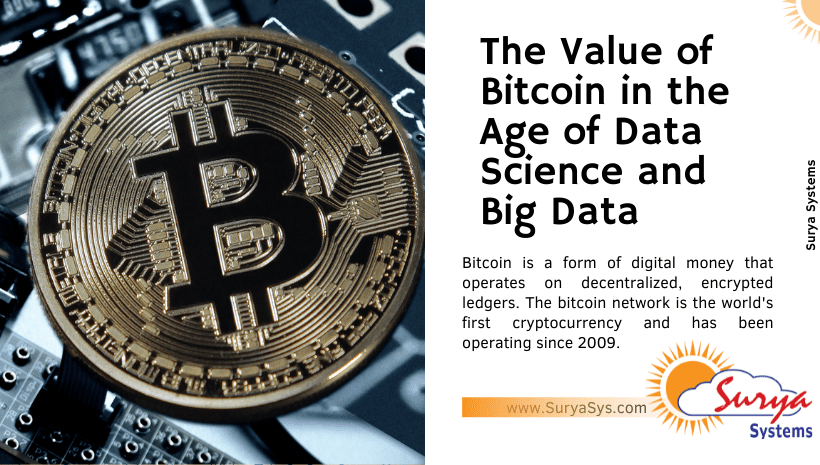- December 20, 2021
- Posted by: Sean Cooper
- Category: Tech Updates

Bitcoin:
Bitcoin is a form of digital money that operates on decentralized, encrypted ledgers. The bitcoin network is the world’s first cryptocurrency (founded by Satoshi Nakamoto in 2008) and has been operating since 2009.
According to cryptocurrency analytics from Statista.com, the price of Bitcoin reached 45,604 USD on May 17, 2021, an impressive increase from 196 USD in October 2013.
Crypto transactions generate an enormous amount of data that can be used for automated investment decision-making. We cannot mention automation without mentioning artificial intelligence (AI), data science, and big data. The idea behind artificial intelligence is to use algorithms to make automated decisions based on data. Using machine learning, data science generates actionable insights, visualizations, and reports based on data. In big data research, we aim to develop software and hardware infrastructure that can handle the five V’s of mass data: volume, velocity, variety, veracity, and value.
What Are the Benefits of Cryptocurrency?
After Bitcoin was launched, the crypto market boomed with the introduction of lots of other cryptocurrencies. According to Coinbase.com, there are 5,129 cryptocurrencies in the market as of May 15, 2021.
In terms of market capitalization, Bitcoin and Ethereum are the two top cryptos, according to Coinbase.com.
Cryptocurrencies are a decentralized and trusted alternative to our current financial systems. Cryptographic transactions are recorded and secured by blockchain, a technology similar to bank balance sheets that continuously verifies transactions and makes all verified changes permanent.
Computational work (solving algorithms) is used instead of human inspection for verification. No banks, institutions, or governments are involved as intermediaries. In its place, crypto blockchains are distributed and shared with all holders in the network, forming a decentralized system that enables all participants to have full control over their assets. Let’s see how big data analytics can help here.
Predictions and analysis of cryptographic data:
In the crypto space, big data and data science can be used for cryptocurrency analytics. Big data infrastructure can handle the massive amount of cryptocurrency data generated from transactions. Data science techniques can provide useful insights into investments and predict future outcomes. It is possible to analyze transaction data to determine the price fluctuations of any given crypto (doing Bitcoin future predictions, for example), allowing investors to increase profitability and prevent substantial losses. Furthermore, social-based data can also be used to train crypto forecasting. By combining user activities and participation with transaction data, market price, and computational power, better predictions on the market volatility over time can be made.
Using AI to forecast cryptocurrency prices:
Using AI cryptocurrency, here are some attempts to predict crypto price and market volatility:
- McNally et al. used Bayesian long short-term memory networks to predict Bitcoin price trends
- Nakano et al. used neural networks to predict Bitcoin intraday trading
- In order to predict the Bitcoin price, Jiang and Lee applied Bayesian neural networks to blockchain data. The implementation produced low error rates.
Big data analytics can be used to predict market volatility and reliable implementations can be developed into crypto trading systems. A similar approach can be applied to cryptocurrency since Wall Street carries out almost 90% of its trading volume algorithmically. However, these data-driven, automated crypto trading services are yet to reach the level of human expertise.
Big Data Analytics Enhances Blockchain Security:
Blockchain technology allows peer-to-peer data sharing that is safe and irreversible. Nevertheless, a government-less system naturally attracts cybercrime, so it must be continually guarded. By implementing artificial intelligence cryptocurrency, crypto networks can be made more secure, such as identifying fraudulent user behavior, preventing thefts, and preventing information leaks. The blockchain can be maintained as a secure place to conduct transactions by proactively uncovering anomalous patterns and activities.
Data Science and Risk Management:
In addition to discussing data science and crypto for market price prediction and blockchain security enhancement, let us look at how AI can be applied to monitor and manage crypto risks.
Cryptocurrencies are subject to external factors, such as community sentiment, blockchain forking, regulatory updates, the rise of competitors, technological advancements, major social events, and marketing campaigns. By combining data from these sources with transaction data for analysis, it is possible to forecast potential changes in cryptocurrencies.
Usually, two events increase the Bitcoin price significantly: forking and halving. Up until 2012, blockchain miners were rewarded with 50 Bitcoins for every successful Bitcoin block validation. The rewards per validated block were halved in May 2021 to 6.25 Bitcoins. Forking occurs when a cryptocurrency blockchain is divided into two, creating two separate records of transactions. This changes the price and market capitalization of the cryptocurrency involved.
Using Bitcoin and cryptocurrency to visualize market movements:
- Using sentiment analysis on tweets related to the short-term overreaction tendency of crypto investors, Colianni et al. predicted price volatility.
- Kim et al. used sentiment classification to predict bitcoin price and transaction volume from user comments in some online crypto communities.
- Sentiment analysis of social media data was used by Lu et al. to determine the factors of Bitcoin adoption in Taiwan.
Public opinion heavily influences the crypto market. Social media is a hotbed for many kinds of opinions, so it is a good place to scrape public sentiments regarding cryptocurrencies. As general crypto or Bitcoin visualizations, these sentiments can show how public opinion affects the crypto market. Bullish forum posts positively influence the Bitcoin returns on a daily basis, whereas micro-blogs influence the Bitcoin market on an hourly basis.
Intelligent Fraud Detection System:
Fraud attempts are a constant threat to the rapidly developing crypto market. CipherTrace reported that crypto-related hacks, thefts, scams, and fraud in the first four months of 2021 caused a loss of 432 million USD. The loss was 4.5 billion USD for 2019 and 1.9 billion USD for 2020. The majority of Initial Coin Offering (ICO) scams target users who are unaware of crypto. Statis Group reported that over 80% of ICOs in 2017 were scams.
Crypto is a relatively new topic compared to AI. There are numerous ways in which data-driven approaches can help advance cryptocurrency operations, but for now, the key determinant of crypto value fluctuations is public sentiment.
https://www.suryasys.com/better-health-outcomes-with-ai-powered-virtual-assistants/
